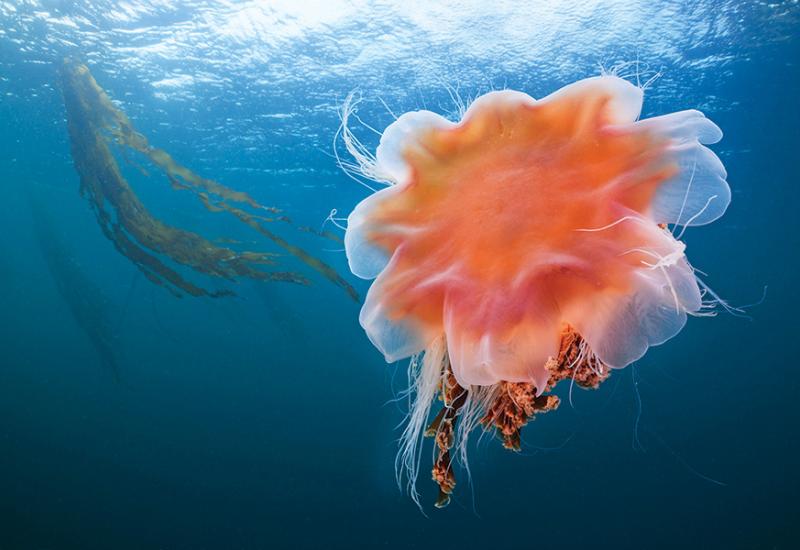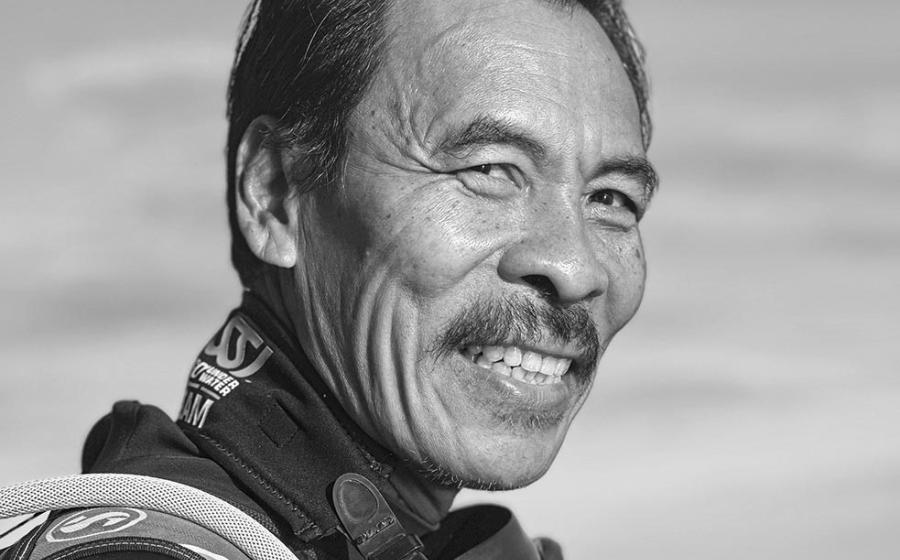The Best Dive Destinations for Macro Photography
Small critters steal the show at these six dive meccas!
Bay Islands

Greg LecoeurA trumpetfish cruises the reef in the Bay Islands, home to mild dive conditions and a host of small wonders.
With its warm waters free of currents and its nearshore reefs—many within swimming distance of the beach or a two-minute boat ride away—Roatan, Honduras, excels in offering macro seekers ideal conditions for ample time on the hunt.
“We have very steady temperatures where it’s always between 80 and 85 degrees,” says Ronald Reyes, instructor with Barefoot Divers, part of the Barefoot Cay Resort located on the island’s southern coast. “You can take all the time you need,” he says.
That kind of time can bring you face to face with seahorses, painted elysias, pipefish, flying gurnards, triggerfish and a host of other finds.
At night, chances are fair that divers will spot a toadfish. “They tend to stay in the same crevices, so the guides can find them again and again in the same spots,” says Reyes. “And, at the very least, you’ll most certainly hear them on almost every night dive.”
READERS PICKS
Resorts
Anthony’s Key Resort, Roatan, Honduras
CocoView Resort, Roatan, Honduras
Mayan Princess Beach & Dive Resort, Roatan, Honduras
Turquoise Bay Dive & Beach Resort, Roatan, Honduras
Operators
Anthony’s Key Resort Dive Shop, Roatan, Honduras
Barefoot Divers, Roatan, Honduras
CocoView Resort, Roatan, Honduras
Dockside Dive Center, Roatan, Honduras
Subway Watersports, Roatan, Honduras
Utila Dive Lodge Dive Center, Honduras
Liveaboards
Roatan Aggressor, Honduras
Bonaire
“The most exciting animals to find on a dive here are nudibranchs, though as a dive location we are known for so much more than just our slugs,” says Pieter de Groot about the tiny Caribbean island where he works as the house photographer for Dive Friends Bonaire, the PADI Five Star Center at Delfins Beach Resort.
Bonaire is famous for delivering sure-thing encounters with frogfish and seahorses. Its reefs are also crawling with crabs: decorator crabs, arrowhead crabs, blue-eyed hermit crabs and the gaudy clown crab. The list of shrimps is equally long, including squat anemone shrimp—aka the “sexy shrimp”—as well as red snapping shrimp, spotted cleaner shrimp and Pederson’s cleaner shrimp.
Bonaire is an especially good place to see it all because many dive centers, like Dive Friends, offer instruction so that you become your own best asset when it comes to finding critters. “We teach courses in recognizing all these little underwater miracles,” says de Groot. Dive Friends offers the PADI Fish Identification course and the PADI Underwater Naturalist course. “Plus, we teach our guests about macro photography, and you can learn from all the staff as we are trained in spotting and recognizing the life that calls this island home.”
READERS PICKS
Resorts
Buddy Dive Resort, Bonaire
Carib Inn, Bonaire
Divi Resort, Bonaire
Eden Beach Resort, Bonaire
Plaza Resort, Bonaire
Operators
Buddy Dive, Bonaire
Carib Inn Dive Center, Bonaire
Divi Flamingo Divers, Bonaire
Toucan Divers at Plaza Resort, Bonaire
VIP Diving Bonaire
Wannadive Bonaire at Eden Beach Resort, Bonaire
Indonesia

Tobias FriedrichA pair of pygmy seahorses in Raja Ampat, Indonesia.
Indonesia is practically synonymous with the weird and wonderful. Sure, it sees more than its share of whale sharks and mantas, but it is also resplendent with tiny finds—so bizarre that even after a diver lays eyes on them, their existence is hard to fathom. That’s true of the pygmy seahorse, tiny as your pinky nail; the Pontoh’s, Bargibant’s, Denise’s and Walea varieties can be found in Indonesia.
Raja Ampat in particular, home to the highest known concentration of biodiversity, excels in delivering the little—from coconut, mimic, blue-ring and wonderpus octopus species to rhinopias, frogfish, stargazers, bobtail squid and a host more.
Meridian Adventure Resort, located on Waigeo Island in the West Papua province, offers prime access to this territory, including its muck, reef and wall dives.
READERS PICKS
Resorts
Wakatobi Dive Resort, South Sulawesi, Indonesia
Operators
Wakatobi Dive Resort Dive Center, Indonesia
Liveaboards
The Arenui, Indonesia
All Star Aurora, Indonesia
Dewi Nusantara, Indonesia
Pelagian Yacht, Sulawesi, Indonesia
Fiji
Beqa Lagoon Resort in Fiji is famous for its shark dive—but that shark dive wouldn’t be possible if it didn’t have the reef life to support it. The Great Beqa Reef stretches along 190 miles of this Fijian island’s coastline and is home to nudibranchs, mantis shrimp, ghost pipefish, leaffish and so many more critters.
What’s perhaps best of all about this South Pacific island nation is the backdrop it offers photographers. This soft-coral capital of the world is a parade of purples, pinks, oranges and reds.
Says Alex Ilnitsky, owner of Beqa Lagoon Resort, “It’s all the colors here—they’re amazing, whether you’re shooting seahorses or blue dragons.”
READERS PICKS
Resorts
Beqa Lagoon Resort, Fiji
Operators
Beqa Adventure Divers, Fiji
The Florida Keys

Kype LippenbergerA flamingo tongue snail in Key West, Florida.
“Most people aren’t looking for things under 5 inches—most people want to see Jaws,” says Frank Slifka, instructor at Captain Hook’s Dive Center, with three locations in the lower Florida Keys.
Those who do train themselves to look low will find a healthy array of macro diversity in this destination.
Of the three known species of flamingo tongue snails, two can be found climbing the soft corals of the Keys. Simply spotting this snail might not do much for you, but there’s also the chance to learn about its behavior. “They leave a slime trail that other flamingo tongues will follow, so if you look, you will often see four or five on that same path,” he says.
And the animal isn’t as harmful as some divers believe. “They eat slowly enough that it allows the soft coral to regenerate behind them.”
Beyond just the snails, the Keys are home to nudibranchs, coral banded shrimp, flatworms, slugs and lots more.
As for the best sites, Haystacks Reef in Key West is popular among macro shooters, as is Samantha’s Reef in Marathon. Really, anywhere in the Keys can be good if you know the tricks. “The ledges and overhangs are neat places to look—you turn yourself over and look up and you’ll find a lot of things crawling,” Slifka says. “You just have to learn to think small.”
READERS PICKS
Resorts
Courtyard by Marriott Key Largo, Florida Keys
Dive Amoray, Key Largo, Florida Keys
Holiday Inn, Key Largo, Florida Keys
Marina Del Mar, Key Largo, Florida Keys
Operators
Dive Key West, Florida Keys
Horizon Divers, Key Largo, Florida Keys
Ocean Divers, Key Largo, Florida Keys (now owned by Rainbow Reef)
Rainbow Reef, Key Largo, Florida Keys
Washington
Tides dominate Puget Sound, so stepping in for a shore dive here requires timing the entry and exit to stay safe.
For those willing to take on this challenge, Washington state offers some of the most scenic cold-water diving on the planet.
Take a site such as Titlow Beach, a former ferry slip in Tacoma. “There are two huge white walls of anemones going up around you,” says Mike Adams, manager of Underwater Sports, a dive center serving the Tacoma area.
Plus, the site—like much of Puget Sound—is an invertebrate paradise. Every dive nets at least half a dozen nudibranchs, including the alabaster variety.
“There’s also a pair of mated wolf eels,” says Adams. “The male is so old that he’s a whitish gray, and the female is a beautiful off-green, blue color. They’re just stunning.” Of course, the spot also delivers when it comes to sightings of the giant octopus, which is what most out-of-staters come to see.










